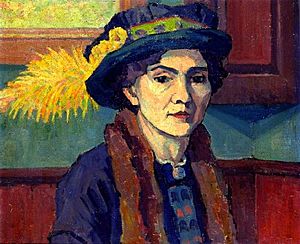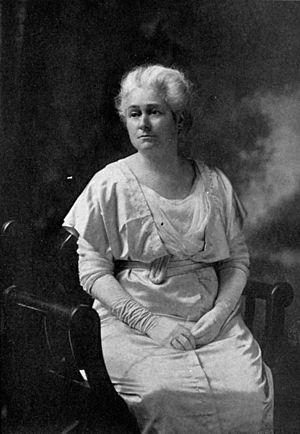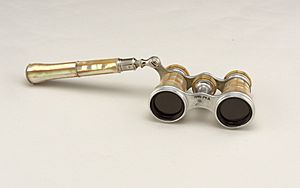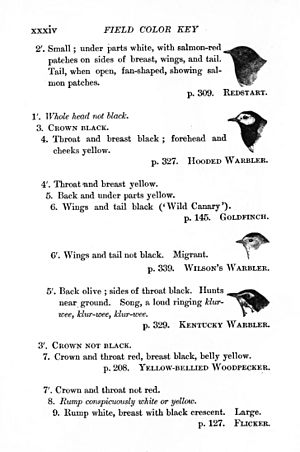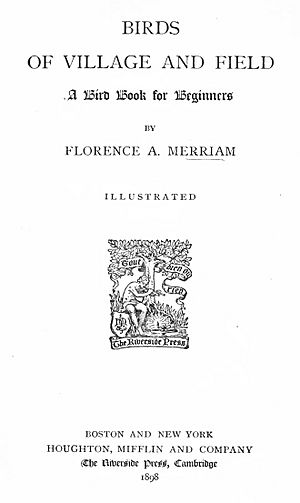Florence Augusta Merriam Bailey facts for kids
Quick facts for kids
Florence Augusta Merriam Bailey
|
|
|---|---|

Florence Merriam, 1904, Portrait from The Condor
|
|
| Born |
Florence Augusta Merriam
August 8, 1863 Locust Grove, New York, United States
|
| Died | September 22, 1948 (aged 85) |
| Resting place | Locust Grove, New York, United States |
| Nationality | USA |
| Alma mater | Smith College (attended, 1882–1886; awarded, 1921), Stanford University |
| Known for | First modern field guide for birdwatchers, regional ornithology, bird conservation |
| Spouse(s) | Vernon Orlando Bailey |
| Awards | Brewster Medal |
| Scientific career | |
| Fields | Ornithology |
Florence Augusta Merriam Bailey (born August 8, 1863 – died September 22, 1948) was an American scientist who studied birds. She was known as the "First Lady of ornithology," which means the study of birds.
Florence was a nature writer and worked hard to protect birds. She helped start early chapters of the Audubon Society, a group that helps protect birds and nature.
She wrote many books about birds for both everyday people and other scientists. Her first book, Birds Through an Opera-Glass (1890), is thought to be the first modern guide for watching birds in nature. She traveled a lot in the American West, often with her husband, Vernon Orlando Bailey, who studied mammals. Her travels helped her write important books like Handbook of Birds of the Western United States (1902) and The Birds of New Mexico (1928). For The Birds of New Mexico, she won a special award called the Brewster Medal.
Contents
Life and Work
Early Life and Family
Florence Augusta Merriam was born on August 8, 1863, in Locust Grove, New York. Her parents were Clinton Levi Merriam and Caroline Hart Merriam. She had two older brothers, Clinton Hart (C. Hart) and Charles Collins.
Florence grew up on her family's property called "Homewood." Her father was interested in science and even wrote letters to famous naturalist John Muir. Both Florence and her brother C. Hart were encouraged to study natural history and astronomy by their parents and aunt. They both became interested in birds very early. When Florence was just 9 years old, she went with her father and brother on a two-month trip to Florida to collect specimens.
When Florence was a teenager, her health was sometimes not very strong. She went to a private school to get ready for college. In 1882, she started at Smith College. She chose her own classes, so she got a certificate instead of a full degree when she finished in 1886. Later, in 1921, Smith College gave her a bachelor's degree. She also attended lectures at Stanford University for six months.
Florence and her family met the naturalist Ernest Thompson Seton during a college break. Seton encouraged Florence to study living birds in their natural homes. In 1885, Florence joined the American Ornithologists' Union (AOU), a group for bird scientists. She was the first woman to become an associate member of the AOU.
Florence and her mother often spent winters in New York City because the climate was milder. In New York City, Florence worked with groups that helped young working women. She even taught them about birds in the summer of 1891.
Florence and her mother sometimes traveled for their health. Doctors at the time often suggested going to drier, higher, and sunnier places for certain illnesses. Her mother, Caroline, passed away in 1893. Florence also likely dealt with health challenges, though her specific illness was not always officially named.
Working to Protect Birds
When Florence first became interested in birds, most people studied them by collecting dead birds or their skins. But Florence wanted to study living birds and how they behaved in nature. At that time, it was very popular for women to wear bird feathers on their hats. Florence thought this was wrong. In 1885, she started writing newspaper articles to speak out against this fashion.
In 1886, she worked with George Bird Grinnell and a classmate, Fannie Hardy, to start the Smith College Audubon Society. This was a local part of Grinnell's new Audubon Society, which aimed to protect birds. They even invited famous naturalist John Burroughs to join them on nature walks.
After moving to Washington, D.C., Florence helped start the Audubon Society of the District of Columbia in 1897. She began teaching bird classes there the next year. She also became active with the American Ornithologists' Union's Committee on Bird Protection. Thanks in part to her work, the study of birds began to focus more on living birds rather than just dead ones.
Florence was dedicated to teaching people how valuable living birds are. She kept working to protect them. Because of her efforts and others, the Lacey Act of 1900 was passed. This law made it illegal to trade wildlife that had been caught, moved, or sold against the law. This was an important step in stopping the killing of birds, especially seabirds like pelicans, for their feathers. Eventually, more laws, changing fashion, and continued education helped stop birds from being killed for hat decorations.
Studying Birds in Nature
Florence Merriam's idea of a birdwatching field guide was new and exciting. It focused on observing living birds in nature. Her book, Birds Through an Opera-Glass (1890), is seen as the first modern bird guide. She wrote it when she was 26, using notes she had published earlier. This first book described 70 common bird species from her home area. It was written for women and young people and was described as "charming, simple, and useful."
In 1889, before her first book came out, Florence began taking many trips to the western United States. She visited her uncle in San Diego County, California, partly to help her health.
After her mother passed away in 1893, Florence returned to the West, visiting Utah and Arizona. She wrote about these experiences in My Summer in a Mormon Village (1894), which was a travel story.
Her second trip to California, where she studied birds while riding a horse, led to her book A-Birding on a Bronco (1896). This book was the first to have illustrations by the famous artist Louis Agassiz Fuertes. When she returned from the West, Florence lived with her brother C. Hart in Washington, D.C.. There, she helped organize local groups for the Women's National Science Club.
In Birds of Village and Field (1898), Florence made her bird guide even bigger, including more than 150 species. This book was also for beginners. It had drawings by Ernest Thompson Seton, Louis Agassiz Fuertes, and John L. Ridgway.
Florence Merriam believed that to study birds, you needed:
- "a careful mind"
- "lots of patience"
- "a notebook"
- "and opera-glasses."
She said that patience helps you train your ears and eyes, and a careful mind stops you from making quick or unsure guesses.
On December 18, 1899, Florence Augusta Merriam married Vernon Orlando Bailey. He was a chief naturalist for the U.S. Bureau of Biological Survey and a long-time friend of her brother C. Hart. They built a home in Washington, D.C., where they welcomed many other naturalists and scientists. They encouraged many young people to study natural history.
Florence and Vernon traveled widely together. They usually spent spring and summer camping in the West and returned to Washington, D.C., in the fall. Their first trip together was in April 1900, from Corpus Christi, Texas to Brownsville, Texas. They traveled 260 miles in 17 days, collecting specimens and taking photos. They even found a new type of plant that grows on other plants.
With her book Handbook of Birds of the Western United States (1902), Florence started writing for a more scientific audience. This book was a major work about birds and went along with Frank Chapman's guide for eastern North America. Florence's book used the best research available, studied bird specimens, included 600 illustrations, and used her own field notes. It remained an important book for studying birds in different regions for at least 50 years. It described bird behaviors like nesting, feeding, and singing in a lively way.
Starting in 1903, the Baileys did a lot of research in what was then New Mexico Territory. For the next three summers, they explored the area.
Over the next three decades, Florence and Vernon covered much of the American West. They explored southern California in 1907, North Dakota in 1909, 1912, and 1916, coastal Oregon in 1914, and Glacier National Park in 1917. Florence wrote many articles about prairie birds and birds in Oregon's forests, mountains, and coasts for different science journals. The results of their work in Glacier Park were published together as Wild Animals of Glacier National Park (1918).
After another scientist, Wells Cooke, passed away in 1916, Florence was asked to use his notes and finish a book about New Mexico's birds. She greatly updated and added to Cooke's information, creating a huge and important book. She was given full credit as the author. The Birds of New Mexico included 24 color pictures and many drawings and photos. It is considered her most important work. It was finished in 1919 but took 9 more years to find money to print it. It was finally published in 1928. For this achievement, Florence became the first woman fellow of the American Ornithologists' Union in 1929 and won the Brewster Medal in 1931.
Florence had visited Arizona in the 1890s. She returned several times in the 1920s for more field work. Her last published work was Among the Birds in the Grand Canyon Country, published in 1939, ten years before she passed away.
Even though she and her husband were very active, traveling across the country and hiking, Florence Merriam Bailey studied nature in a gentle, quiet way. She wrote that you should "be content to sit and listen to the voices of the marsh."
Later Life and Passing
Florence Merriam Bailey passed away in Washington, D.C., on September 22, 1948, due to heart problems. She is buried at her family's old home in Locust Grove, New York.
A scientist named Paul Oehser wrote that Florence Merriam Bailey's early books were as good as those by famous naturalists like Muir and Burroughs. He said she was "one of the most literary ornithologists of her time," meaning she loved birds, was great at observing them, was a talented writer, and respected science.
Some of Florence Merriam Bailey's writings, including her diaries, photos, and field notes, are kept at the Smithsonian Institution Archives.
Awards and Recognition
Florence Bailey achieved many "firsts" for women in science:
- She became the first woman associate member of the American Ornithologists' Union (AOU) in 1885.
- She was the first woman fellow of the AOU in 1929.
- She was the first woman to receive the AOU's Brewster Medal in 1931, for her book Birds of New Mexico.
- In 1933, she received an honorary law degree from the University of New Mexico.

She was also a founding member of the Audubon Society of the District of Columbia and often taught basic bird study classes for them. In 1908, a scientist named Joseph Grinnell named a type of mountain chickadee from California Parus gambeli baileyae in her honor. This means a part of the bird's scientific name is "baileyae" to recognize her.
In 1992, a mountain in southern Oregon was named Mount Bailey. It was named to honor both Florence and Vernon Bailey for their contributions to natural history.
Sample Illustrations
Here are some pictures from Florence Merriam Bailey's books.
Images for kids
-
Bailey's 1886 yearbook photo from her time at Smith College.
-
Bailey and several other individuals gathered at Lake Placid, New York
See also
 In Spanish: Florence Augusta Merriam Bailey para niños
In Spanish: Florence Augusta Merriam Bailey para niños


